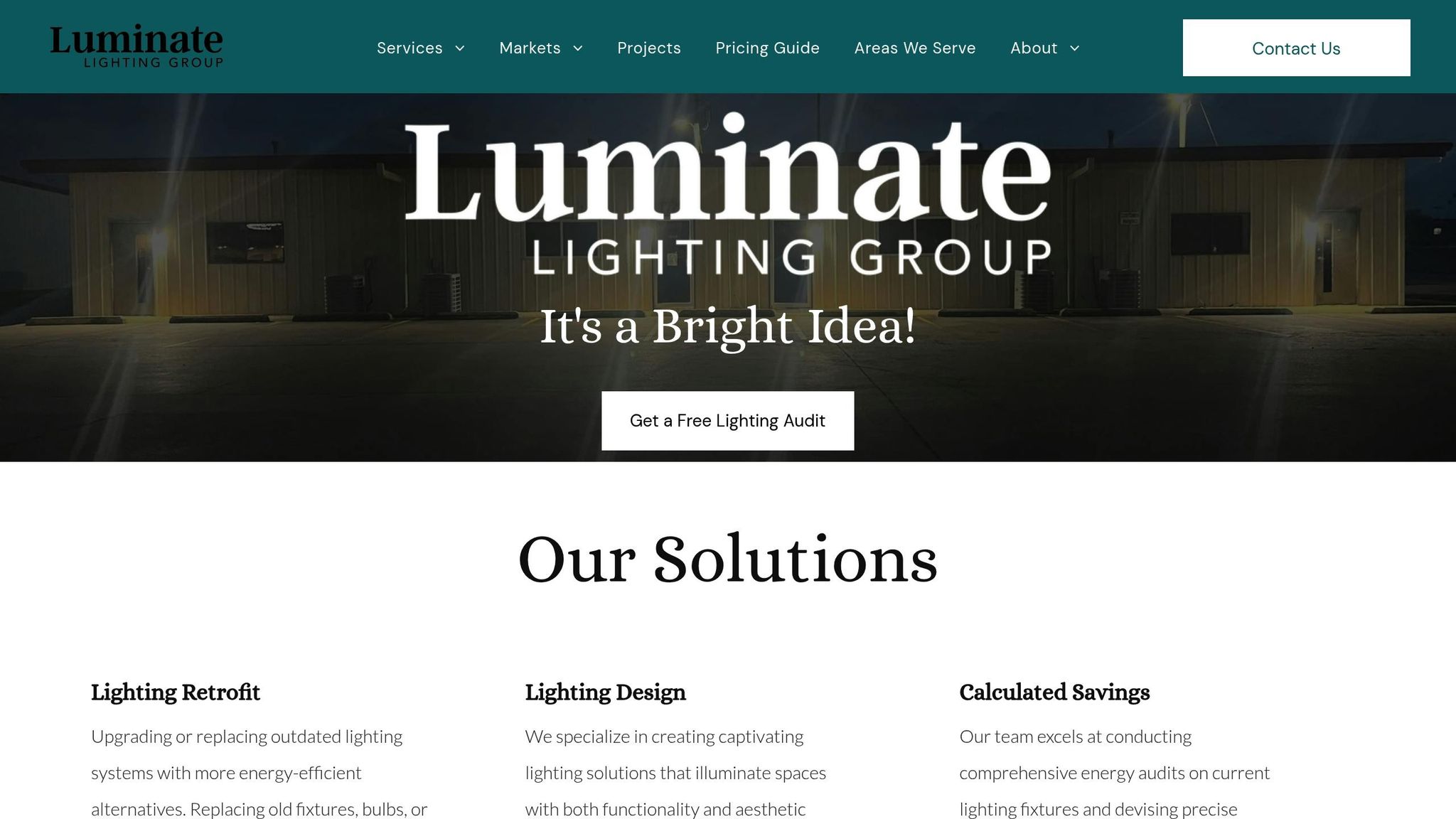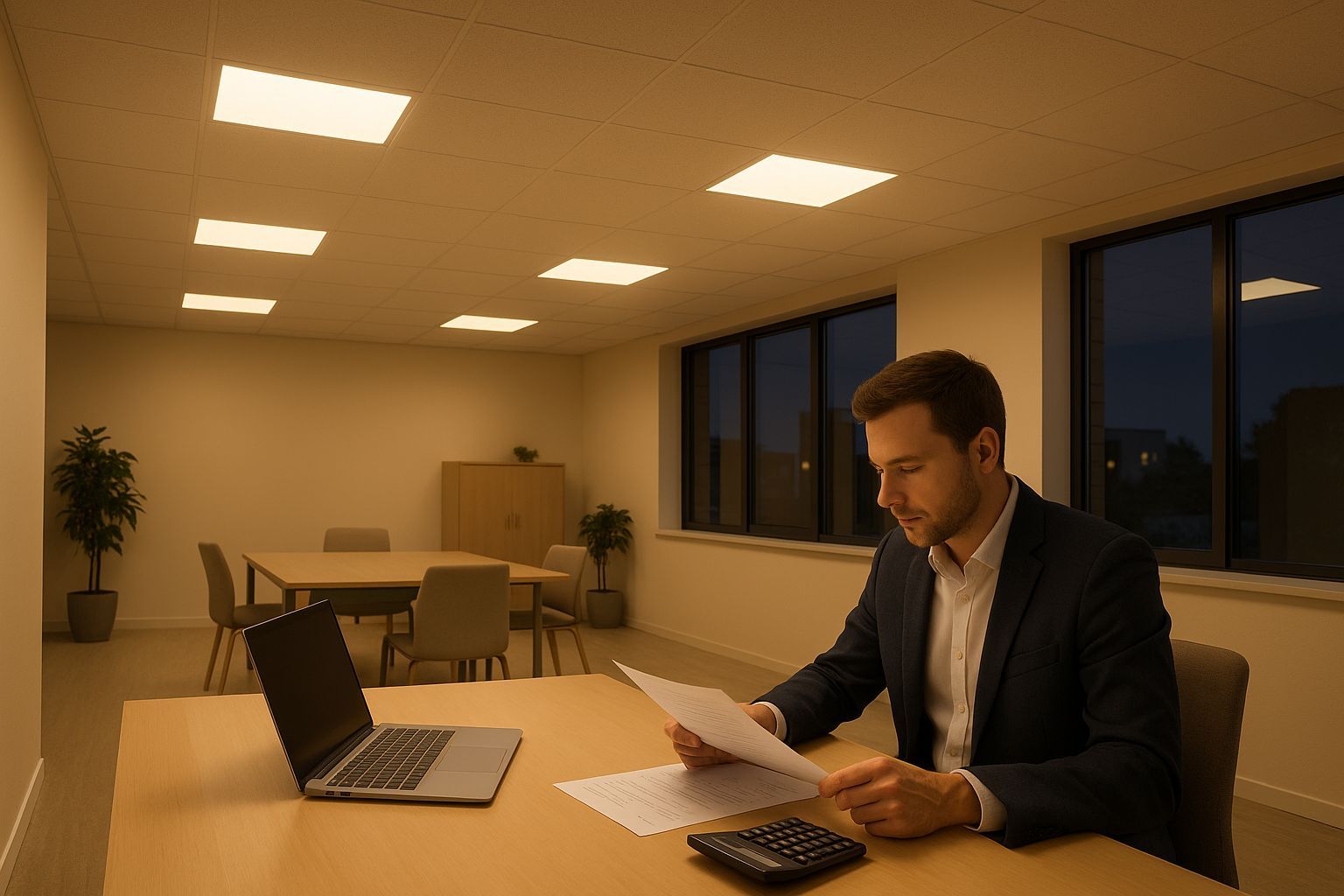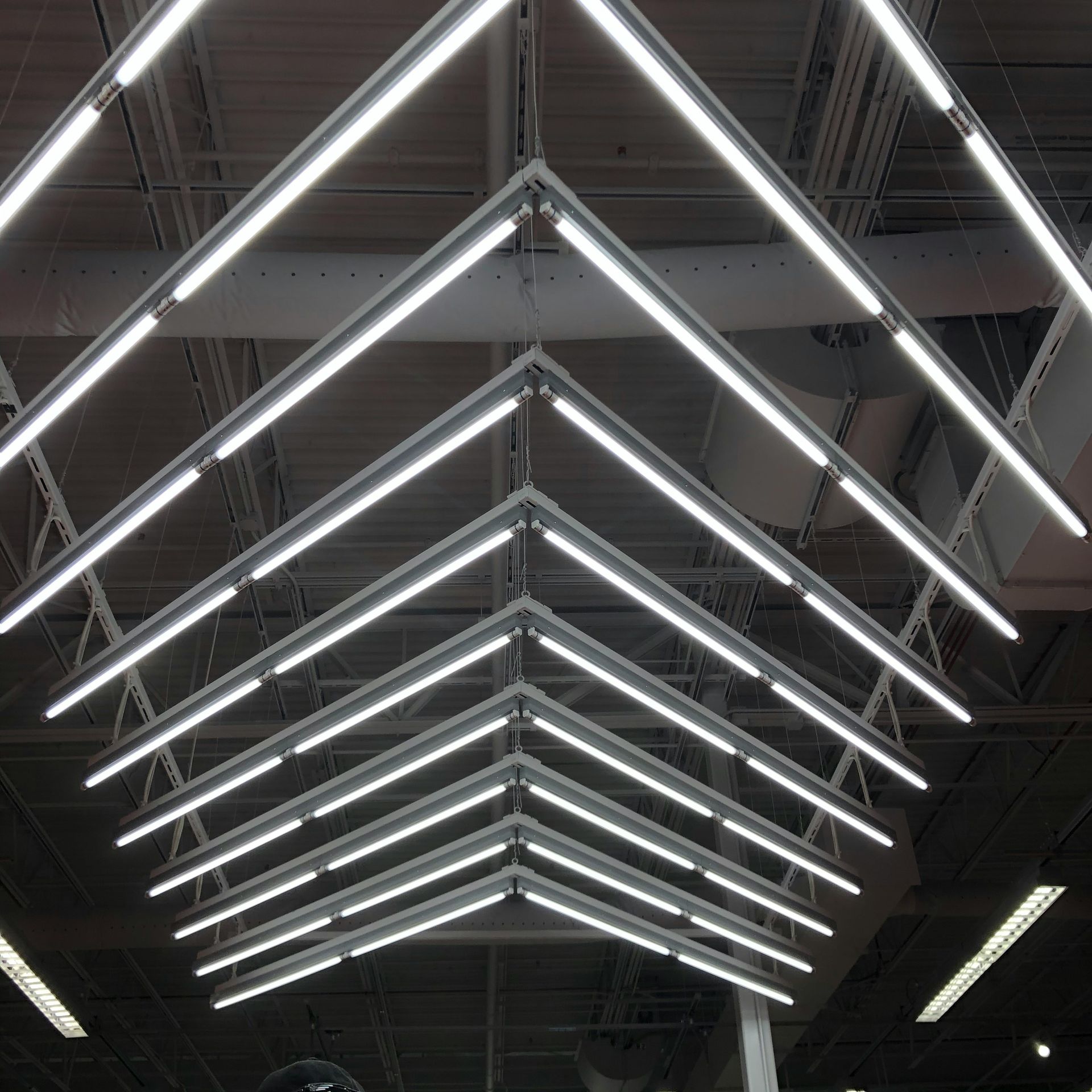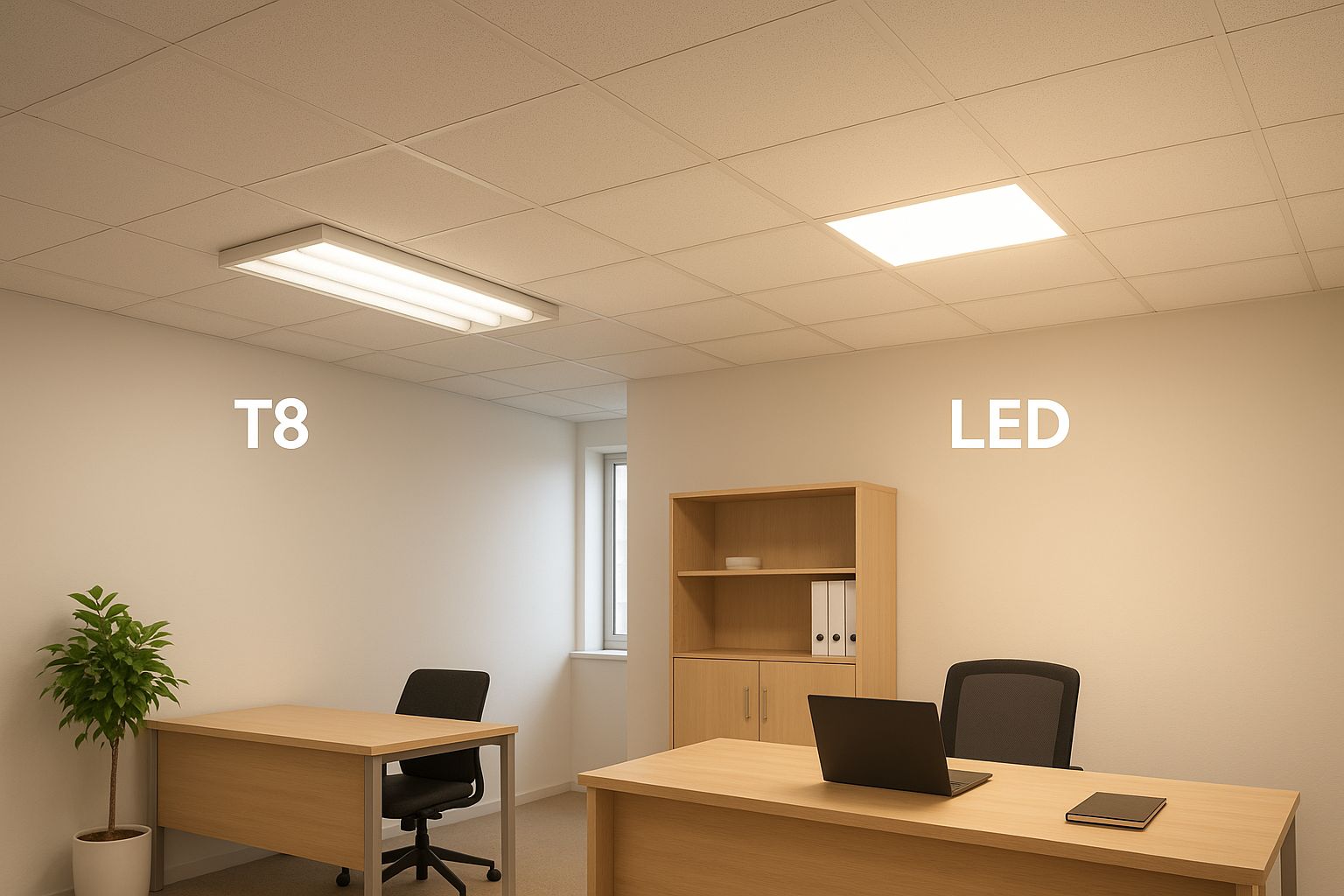Energy Audit vs Lighting Assessment: Key Differences
Energy Audit vs Lighting Assessment: Key Differences
Want to cut energy costs but unsure where to start? Here’s a quick breakdown:
- Energy Audits: These are in-depth evaluations of all energy-consuming systems in a facility, including HVAC, lighting, insulation, and electrical equipment. They aim to identify inefficiencies and can reduce energy bills by 5%-30%.
- Lighting Assessments: These focus specifically on lighting systems, evaluating efficiency, quality, and performance. They’re ideal for quick upgrades, like switching to LEDs, which can cut lighting energy use by up to 85%.
Which should you choose?
- Energy Audit: Best for addressing multiple systems and long-term savings.
- Lighting Assessment: Perfect for targeted lighting improvements and faster results.
Quick Comparison:
| Aspect | Energy Audit | Lighting Assessment |
|---|---|---|
| Scope | Entire facility systems | Lighting systems only |
| Duration | Weeks to months | Days to weeks |
| Savings Potential | Up to 30% on total energy costs | Up to 85% on lighting energy costs |
| Cost | Higher due to broad analysis | Lower, as it’s more focused |
If your energy bills are high across the board, go for an audit. If lighting is the main issue, a lighting assessment is the better choice.
Energy Audit Tool – Lighting and Sensors
What Is an Energy Audit?
An energy audit is a thorough evaluation of a building's systems to identify areas where energy is being wasted. Unlike assessments that target a single component, energy audits take a comprehensive approach, examining everything from HVAC systems and lighting to the building envelope and electrical equipment.
Purpose and Focus
The main goal of an energy audit is to uncover energy waste and pinpoint opportunities for improvement. By analyzing energy usage patterns, audits provide building owners and managers with actionable insights that can help lower costs and reduce environmental impact.
These audits go beyond simply spotting inefficiencies. They also offer valuable information about your Energy Star rating, allowing you to see how your building stacks up against similar facilities nationwide. Additionally, energy audits help ensure compliance with local, state, and federal regulations.
During the audit, every major energy-consuming system is evaluated, including lighting, HVAC equipment, the building envelope, and electrical systems. This broad approach helps auditors understand how these systems interact, often uncovering opportunities for improvement that might be missed when focusing on individual components. These insights set the stage for the systematic process described below.
Process Overview
Energy audits combine utility bill analysis, on-site inspections, and diagnostic testing to identify inefficiencies.
The process begins with a review of utility bills and energy consumption data from the past 12–24 months. This historical data provides a baseline for understanding energy usage. Next, auditors conduct on-site inspections to examine all energy-consuming systems and equipment. They evaluate lighting, HVAC systems, and the building's envelope integrity.
During the inspection, auditors assess windows, doors, walls, and roofs for air leaks, drafts, and inadequate insulation. HVAC systems are checked for proper operation, including an evaluation of filters, ducts, and coils. Lighting systems are reviewed for fixture efficiency, control mechanisms, and usage patterns, all of which contribute to the overall energy profile.
Once data is collected, auditors use diagnostic tests and compare findings to industry benchmarks. This analysis helps prioritize recommendations, focusing on the most cost-effective upgrades and those with the highest potential for energy savings and return on investment.
Tools and Standards Used
To ensure precision, energy auditors rely on advanced tools and established standards. These tools help gather accurate data about a building's energy performance. Commonly used equipment includes infrared cameras, power meters, and energy modeling software.
Here’s a closer look at some of the tools:
- Infrared thermometers and cameras: Used to detect temperature variations and assess the building envelope for air leaks.
- Power meters: Measure the energy consumption of individual equipment.
- Airflow measurement devices: Evaluate ventilation levels in ducts and HVAC systems.
- Temperature and humidity loggers: Assess HVAC system effectiveness.
- Combustion analyzers: Analyze the efficiency of boilers and furnaces.
Software also plays a critical role. Energy modeling software simulates a building’s energy usage, while tools like the ENERGY STAR Portfolio Manager allow for performance benchmarking against similar facilities. Notably, about 25% of U.S. commercial buildings actively benchmark their performance using this tool.
Energy audits adhere to ASHRAE audit levels, ensuring consistency and accuracy. The American Society of Heating, Refrigerating and Air-Conditioning Engineers (ASHRAE) has defined three levels of audits:
- ASHRAE Level 1 (Walk-through Analysis): A basic overview to identify obvious inefficiencies.
- ASHRAE Level 2 (Energy Survey & Analysis): A more detailed breakdown of energy consumption by specific systems.
- ASHRAE Level 3 (Detailed Analysis of Intensive Capital Improvements): An in-depth engineering analysis focused on potential upgrades.
Additional guidelines, such as ANSI/ASHRAE Standard 100 for building performance and the International Performance Measurement and Verification Protocol (IPMVP), provide frameworks to verify energy savings. These standards ensure that audits are conducted methodically and deliver reliable results.
What Is a Lighting Assessment?
A lighting assessment is a focused evaluation of a facility's lighting systems. Unlike broader energy audits, which examine all building systems, this type of assessment zeroes in on lighting efficiency, safety, and performance. By concentrating on lighting alone, experts can analyze illumination levels, fixture effectiveness, and control systems while spotting potential hazards. This detailed approach helps lay the groundwork for understanding its advantages and methodologies.
Purpose and Focus
The primary goal of a lighting assessment is to improve energy efficiency, ensure compliance with codes, and enhance the quality of lighting. In industrial settings, proper lighting plays a key role in boosting productivity, improving safety, and ensuring smooth operations.
"Industrial fixtures lighting is a vital component of any industrial environment, influencing safety, productivity, and overall efficiency." - PacLights
A lighting assessment examines whether current systems adequately support workplace tasks. Well-lit environments are safer, reducing the risk of accidents and injuries while fostering a more efficient workspace.
Energy efficiency is another critical aspect. For example, LED lighting is about 44% more efficient than fluorescent options, and facilities can cut energy costs by up to 85% compared to traditional lighting solutions. Additionally, LED fixtures have a lifespan up to 25 times longer than incandescent bulbs, significantly lowering maintenance expenses. Beyond cost savings, effective lighting improves morale and reduces workplace incidents.
Process Overview
The lighting assessment process involves analyzing light levels, evaluating fixtures, checking control systems, and verifying compliance. It typically begins with a lighting survey, which combines qualitative observations with quantitative lux measurements to provide a comprehensive picture of the lighting environment.
During the assessment, professionals examine factors like illuminance, luminance, color temperature, and color rendering index (CRI). Measurements are taken at various points throughout the space to address inconsistencies in light distribution and to tailor recommendations to specific tasks.
| Checklist Item | Evaluation Focus |
|---|---|
| Task-Specific Illumination | Ensuring adequate light for specific tasks |
| Glare Issues | Identifying glare and reflection problems |
| Bright Objects | Addressing visual distractions |
| Lighting Transitions | Reducing eye strain from extreme lighting changes |
| Fixture Coverage | Assessing light diffusion quality |
| Light Placement | Avoiding shadows and ensuring uniformity |
Professionals also check fixture conditions, looking for issues like flickering, dirt accumulation, and improper positioning. They explore ways to maximize natural light by rearranging workspaces and optimizing task lighting placement. Tools and established standards guide these evaluations, ensuring precise and actionable results.
Tools and Standards Used
Specialized tools are essential for accurately measuring and analyzing lighting performance. These instruments help assess energy efficiency and workplace safety. Common tools include light meters, spectrometers, and photometric layout software.
- Light Meters: Devices like the Minolta Illuminance & Luminance Meter and Sylvania Light Meter DS3050 measure light levels in lux and footcandles, providing reliable data for analysis.
- Spectrometers: These measure color temperature and CRI to ensure lighting quality meets workplace needs. For instance, the Minolta Chroma Meter evaluates brightness and color differences, converting them into numerical values for precise insights.
- Advanced Tools: Instruments like Marietta's Wall, which collects luminance data at different angles, and the Heliodon, which simulates the sun's path, offer deeper analysis of lighting performance under various conditions.
Photometric layout software is another key tool, allowing professionals to model lighting scenarios, predict performance, and optimize fixture placement. This software helps calculate expected illumination levels across different spaces before installations.
All lighting assessments are conducted in line with workplace lighting codes and safety regulations. Findings are carefully documented, ensuring compliance and providing a valuable reference for future improvements. A thorough lighting assessment not only delivers energy and cost savings but also enhances safety and operational efficiency.
Key Differences Between Energy Audits and Lighting Assessments
Energy audits and lighting assessments both aim to reduce costs and improve efficiency, but they differ significantly in scope, methodology, and outcomes. Understanding these differences helps facility managers select the right evaluation for their needs.
Scope and Coverage
Energy audits take a broad approach, analyzing a facility's entire energy usage across multiple systems like HVAC, insulation, and electrical equipment. On the other hand, lighting assessments focus solely on lighting systems, identifying inefficiencies and areas for improvement.
Methodology and Depth
Energy audits involve a detailed, systematic review of all energy-consuming systems. This process includes extensive data collection and analysis to create in-depth reports. Auditors use specialized tools and inspections to assess the facility’s overall energy performance. Lighting assessments, however, are more focused. They measure illumination levels and fixture efficiency using tools like light meters.
These differences in methodology also impact the complexity and time required for each evaluation.
Time Investment and Complexity
Energy audits are more time-intensive, often taking weeks or even months to complete due to their comprehensive nature. In contrast, lighting assessments are quicker, usually requiring just a few days to a few weeks.
Tools and Equipment
Energy audits utilize a wide array of diagnostic tools, such as infrared cameras to detect heat loss or air leaks, blower door tests for measuring airtightness, and thermographic inspections to identify insulation gaps. Lighting assessments, being more specific, primarily rely on light meters to evaluate lighting performance.
Comparison Table
| Aspect | Energy Audit | Lighting Assessment |
|---|---|---|
| Scope | Comprehensive facility-wide evaluation | Focused evaluation of lighting systems |
| Systems Covered | HVAC, lighting, insulation, electrical equipment | Lighting fixtures and overall illumination |
| Duration | Several weeks to months | Days to weeks |
| Primary Tools | Infrared cameras, blower door tests, thermographic inspections | Light meters |
| Data Requirements | 12–24 months of utility bills, comprehensive building data | Current lighting inventory |
| Report Complexity | Detailed multi-system analysis and recommendations | Focused lighting performance report |
| Typical Savings Potential | Up to 30% on energy bills facility-wide | Varies |
Cost and Investment
The cost of energy audits is typically higher due to their extensive scope and the variety of systems analyzed. Lighting assessments, being more targeted, come with lower upfront costs. This difference in investment reflects the broader versus narrower range of actionable outcomes.
Actionable Outcomes
Energy audits provide recommendations that span multiple systems, addressing issues like duct leakage, which can waste 20% to 40% of heating and cooling energy. Lighting assessments, in contrast, focus on specific upgrades to fixtures and lighting systems, offering immediate energy-saving opportunities.
When deciding between an energy audit and a lighting assessment, consider your facility’s efficiency goals and explore available financial incentives. The right choice depends on the scope of improvements you aim to achieve.
sbb-itb-86fe545
When Should You Choose an Energy Audit or Lighting Assessment?
Deciding between an energy audit and a lighting assessment depends on your facility's priorities and the scope of the issues you're addressing.
When to Choose Energy Audits
If your facility is grappling with widespread energy inefficiencies or unusually high utility bills, an energy audit is the way to go. These audits are designed to tackle inefficiencies across multiple systems, helping to lower energy costs by anywhere from 10% to 40%. For example, if you're noticing unexplained spikes in your energy bills, a comprehensive audit can uncover the root causes and offer actionable solutions.
Energy audits are particularly suited for long-term planning and major investments. They’re also effective when you’re looking to address inefficiencies across your entire operation. In fact, with no-cost adjustments, strategic upgrades, and smarter maintenance, the average commercial building can cut energy bills by up to 30%. Since as much as 30% of energy use in commercial buildings comes from waste, taking a comprehensive approach can result in significant savings.
The type of energy audit you choose depends on your needs:
- A Level I audit offers a basic on-site evaluation to identify obvious inefficiencies.
- A Level II audit goes deeper, with a detailed site inspection and analysis.
- A Level III audit provides extensive data collection and modeling, ideal for facilities planning large capital investments.
Energy audits also go beyond just saving energy. They can help improve indoor air quality by identifying harmful toxins or allergens, and they can boost operational efficiency by pinpointing underutilized equipment.
When to Choose Lighting Assessments
If your main concern is outdated or ineffective lighting, a lighting assessment is your best choice. These assessments are laser-focused on identifying opportunities for lighting upgrades, offering a quick and efficient way to enhance your facility’s lighting.
Lighting assessments are ideal for situations where poor lighting quality is affecting employees or operations. For instance, if your team struggles with dim or uneven lighting, an assessment can quickly recommend solutions to improve both illumination and energy efficiency.
These assessments are typically completed in just a few days, making them a fast and effective option when lighting is the primary focus. They’re especially valuable if your goal is to switch to LED lighting or make immediate improvements. Upgrading to LED lighting, in particular, is often one of the simplest and most impactful steps you can take to improve energy efficiency.
If lighting is your main priority, a targeted lighting assessment delivers fast results and immediate benefits. Once lighting upgrades are complete, you can then explore broader energy efficiency strategies for your facility.
Both energy audits and lighting assessments play a key role in helping you make smarter energy decisions based on your facility's specific needs and goals.
Benefits for Commercial Facilities
Both energy audits and lighting assessments bring measurable advantages to commercial facilities. Understanding these benefits can guide you in selecting the best option for your facility's specific needs.
Energy Audit Benefits
Energy audits provide long-term value by uncovering inefficiencies across various systems like HVAC, lighting, building envelope, and equipment. This holistic evaluation often reveals opportunities for integrated solutions that deliver a strong return on investment (ROI).
In addition to immediate energy savings, audits support sustainability efforts and help facilities comply with evolving energy regulations. This proactive approach not only ensures regulatory compliance but also lays the groundwork for long-term operational efficiency.
By analyzing how different systems interact, energy audits can also improve overall building performance. For example, they may identify ways to enhance indoor air quality, temperature regulation, and occupant comfort - all while reducing energy use.
Another key advantage is the ability to make informed capital investment decisions. Detailed performance data from audits ensures that major upgrades align with your facility’s long-term goals and deliver the expected ROI.
Lighting Assessment Benefits
Lighting assessments offer quick wins with fast payback periods. Since lighting accounts for a significant portion of energy use in commercial buildings, targeted upgrades can yield noticeable savings within months.
But the benefits go beyond cost reductions. Enhanced lighting can boost productivity, reduce eye strain, and create safer work environments, all while ensuring compliance with current safety and lighting codes. As noted by industry experts, "Ensuring lighting compliance for your commercial property is imperative for both legal adherence and energy efficiency".
Energy-efficient lighting solutions identified during assessments also last longer and require less maintenance. For instance, LED technology and smart controls often recommended during assessments reduce the need for frequent replacements and lower overall maintenance costs.
These benefits pave the way for customized solutions provided by Luminate Lighting Group.
Luminate Lighting Group 's Services

Luminate Lighting Group specializes in delivering energy audits and lighting assessments tailored to the needs of US commercial facilities. Their approach helps businesses identify and implement the most effective strategies for achieving energy savings and operational goals.
Their lighting assessment services focus on improving energy efficiency, cutting costs, and enhancing workplace illumination. These services include fixture upgrades, retrofits, and smart lighting controls designed to maximize energy savings and extend system lifespan. Additionally, their expertise in navigating rebate programs helps clients reduce costs and achieve faster payback periods.
For facilities seeking broader solutions, Luminate Lighting Group offers comprehensive energy audits that assess multiple building systems. Their turnkey approach includes detailed analysis, custom recommendations, and professional installation services, all aimed at delivering high-quality, energy-efficient outcomes with minimal disruption to daily operations.
Client feedback highlights the impact of their work. Building owner C. Bennett shared:
"The Luminate team retrofitted the lighting in a few of our commercial properties and I couldn't be more pleased with the quality of the work, the value they provided and the level of service that they provided. I can definitely recommend their work".
Interior designer E. Lambeth remarked:
"I am very happy with how everything turned out on this project. The lighting updates made a huge difference in the overall look of the space. I will absolutely keep you posted on upcoming projects".
Luminate Lighting Group offers a three-tier service approach, allowing facilities to choose services that align with their needs and budget. Options range from basic LED retrofits to advanced lighting designs with smart controls and full-service installation. These scalable solutions ensure that facilities can adapt as their requirements evolve.
Conclusion
Understanding the difference between energy audits and lighting assessments is key to making smart energy decisions. By identifying whether your facility requires a full-scale evaluation or a targeted lighting solution, you can allocate resources wisely and achieve meaningful results.
If you're looking for quick wins, a lighting assessment might be the way to go. For example, switching to LED lighting can cut energy use by 50–75% and significantly lower maintenance costs. On the other hand, an energy audit offers a more comprehensive approach, with the potential to reduce energy expenses by up to 30% over the long term.
Budget considerations also play a major role. Lighting assessments are generally more affordable, while energy audits, though requiring a larger upfront investment, can lead to savings of 10% to 40% on energy costs. Both options, however, contribute to reducing greenhouse gas emissions - by as much as 30% - which not only supports sustainability but also enhances your organization’s reputation.
To make the best choice, start by defining your goals. Are you aiming to cut energy use, improve lighting quality, or reduce maintenance costs? Once you've clarified your priorities, you can decide whether an energy audit or a lighting assessment aligns better with your facility’s specific needs, timeline, and budget.
FAQs
Should I choose an energy audit or a lighting assessment for my facility?
Choosing between an energy audit and a lighting assessment comes down to what your facility needs most.
If your goal is to tackle overall energy consumption, an energy audit is the way to go. This process takes a close look at how your building uses energy, pinpointing inefficiencies in areas like HVAC systems, insulation, and appliances. It’s a comprehensive approach to cutting energy costs and boosting efficiency across the board.
However, if your primary concern is lighting, then a lighting assessment is the better fit. This evaluation zeroes in on your lighting systems, analyzing energy use, lighting quality, and potential upgrades. It’s perfect for improving lighting performance or reducing energy costs tied to lighting.
In short, choose an energy audit for a big-picture energy strategy, and opt for a lighting assessment when lighting is your top priority.
What tools and technologies are commonly used in energy audits, and how do they help identify energy inefficiencies?
Energy audits depend on a range of tools and technologies to pinpoint inefficiencies and improve energy usage. Some of the most commonly used tools include digital multimeters, which measure voltage, current, and resistance, and power meters, which track energy consumption in electrical circuits. These devices are essential for spotting underperforming equipment and identifying electrical issues that could be driving up energy waste.
Beyond handheld devices, many audits now leverage data analysis software and cloud-based platforms to make the process more efficient and precise. These tools can evaluate energy usage trends, identify problem areas, and offer actionable recommendations. This makes it easier to implement energy-saving strategies that are specifically tailored to the unique needs of your facility.
Are there financial incentives or rebates for businesses that complete lighting assessments or energy audits?
Yes, businesses in the U.S. can tap into a variety of financial incentives and rebates for conducting lighting assessments or energy audits. These include utility rebates for switching to energy-efficient lighting systems and federal tax credits, which can sometimes cover up to 30% of the costs for energy-efficient upgrades.
On top of that, many state and local programs offer additional incentives to promote energy efficiency. Since these programs differ depending on your location, it’s worth reaching out to your utility provider or checking with state energy offices to discover options tailored to your area. Leveraging these programs can help lower upfront costs and boost your overall return on investment.




